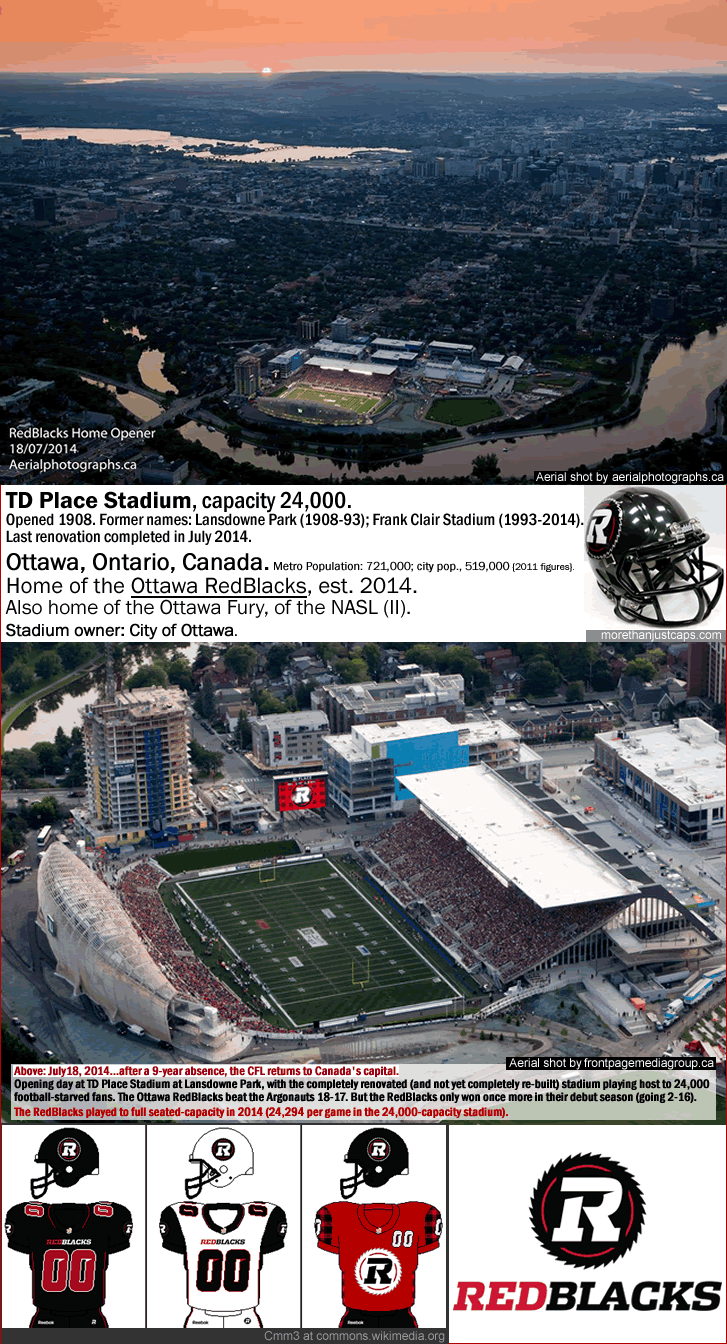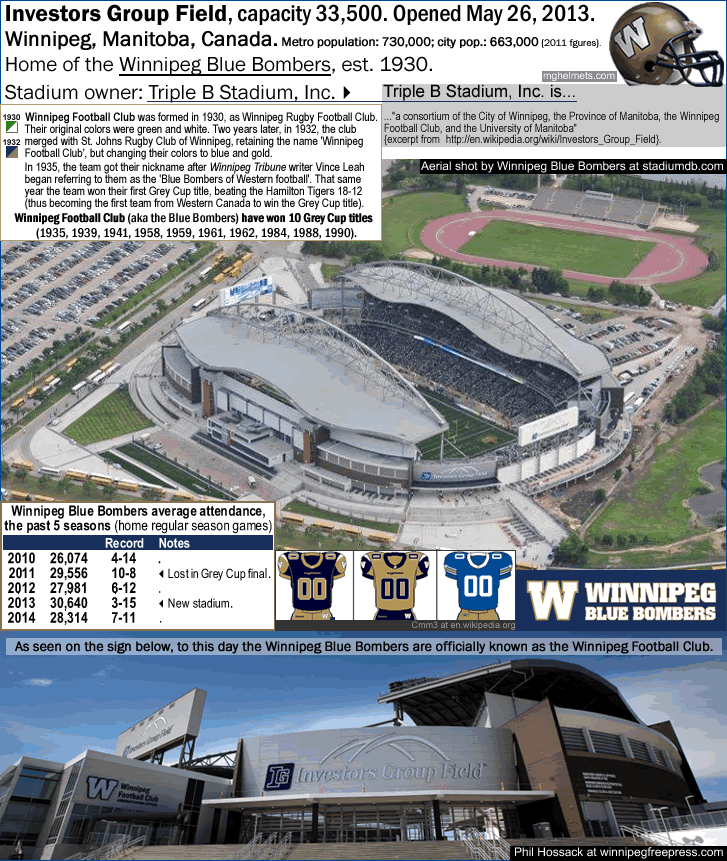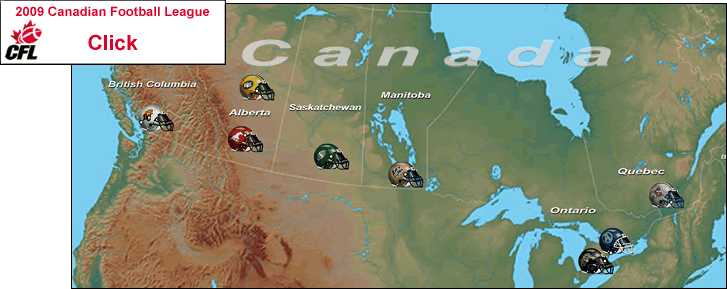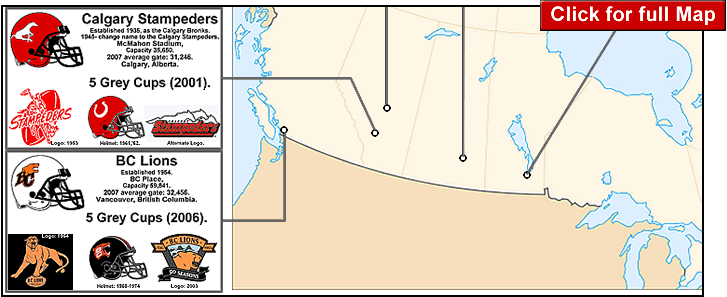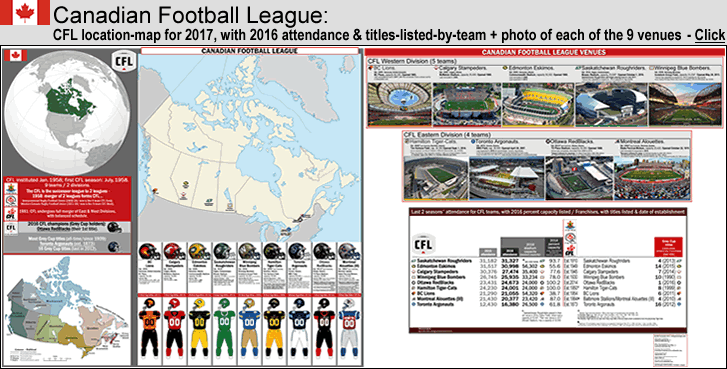
Canadian Football League: CFL location-map for 2017, with 2016 attendance & titles-listed-by-team + photo of each of the 9 venues
…
…
By Bill Turianski on 19 June 2017; twitter.com/billsportsmaps.
Links…
-Teams…Canadian Football League/Teams;
-2017 CFL season (en.wikipedia.org).
-Official site…cfl.ca.
-Schedule, scores, standings, etc…flashscores.co.uk/american-football/canada/cfl/.
-Here is a great blog, Collecting Canadian Football (collectingcanadianfootball.blogspot.com).
…
The 2017 CFL season will be the 60th season since the CFL was founded, but the competition predates that by many decades, and teams in Canada have been competing for the Grey Cup title since 1909. As it says in Wikipedia, “The CFL was officially founded on January 19, 1958. The league was formed from a merger between the Interprovincial Rugby Football Union [Eastern Canada] founded in 1907 and the Western Interprovincial Football Union [Western Canada] founded in 1936.” {Excerpt from Canadian Football League (en.wikipedia.org).}
For most of its existence, and still today, the CFL has been comprised of 9 teams…
West Division: the BC Lions, the Calgary Stampeders, the Edmonton Eskimos, the Winnipeg Blue Bombers.
East Division: the Hamilton Tiger-Cats, the Toronto Argonauts, the Ottawa RedBlacks, the Montreal Alouettes.
The teams play a 20-game regular season, which spans from late June to mid-November; and the playoffs sees 6 of the teams compete for the Grey Cup title, which is held in a different venue each year. Last season saw the relatively new team the Ottawa RedBlacks (est. 2014) win their first Grey Cup title, defeating Calgary 39-33 at BMO Field in Toronto, on Sunday November 27, 2016. Ottawa will host the 2017 Grey Cup, to be played on Sunday the 26th of November.
In 2016, the CFL, overall, averaged 24,691 per game…
That 24,691 per game figure was almost exactly the same as in 2015 (just 46 per game lower than the 2015 overall average attendance of 24,737). The highest-drawing team in the CFL is usually the Edmonton Eskimos, with average crowds in the 30-32-K-range most seasons, but they never have a decent percent-capacity figure because the Eskimos play in the much too large Commonwealth Stadium (which was built for the Commonwealth Games in 1978, and was expanded in 1982, and currently has a capacity of 56.2 K, meaning the Eskimos play to over 24 thousand empty seats most games). But last year, the Saskatchewan Roughriders had the highest attendance, at 31.1 K. And because the Roughriders are about to move into their brand-new purpose-built stadium (Mosaic Stadium, capacity 33,000), Saskatchewan will probably have the highest attendance in 2017 as well. {See this, en.wikipedia.org/wiki/2017_CFL_season#Saskatchewan_Roughriders_new_stadium.}
Toronto: the largest city in Canada, yet the home of the worst-drawing CFL team…
The CFL draws pretty well. Most teams draw easily above 20 K, the glaring exception being Toronto. And last season [2016], two teams – Ottawa and Hamilton – played to above 100-percent-capacity, while two other teams played to near-full-house-capacities (Saskatchewan at 93%, and Montreal at 87%). If you are new to the CFL, and are wondering why Toronto, the largest city by far in Canada, is home to the worst-drawing CFL team, well that is because a vast amount of sports fans in Toronto consider the CFL to be a bush-league organization that is beneath them. And a significant amount of people in Toronto think that a major World-Class city, such as Toronto, deserves major-league things…things like NFL franchises. They don’t know what they are missing, because, having attended CFL games myself, I am here to tell you that the CFL is a great league, with exciting games, offense-friendly rules, passionate fans, cool logos and uniforms, and, by-and-large, excellent venues that host affordable outings. But that is ignored by the majority of Toronto sports fans, and to many in Canada’s largest city, the priority is in attaining an NFL franchise, whether by hook or crook…Toronto has been trying to steal the NFL’s Buffalo Bills for years now. Hey Toronto: you are in Canada, not the United States. And your country already HAS a major-league pro football league. So get over yourselves and live with it. ‘Cuz the Buffalo Bills ain’t moving to Toronto. Maybe you should be more concerned with the major-league teams you already have, Toronto…because that hockey team you got, the one with the idiotic misspelling in their name – the ‘Leafs’ [sic] – they haven’t won a Stanley Cup title in over half a century. That doesn’t sound very major league to me.
…
Note on CFL titles… The CFL pretends that the Montreal Alouettes (II), who folded on June 24 1987, actually went into dormancy. They say this today, after the fact, even though the CFL front office back then didn’t say so at the time, when it was announced that the Montreal Alouettes franchise had folded, at a press conference, organized by the CFL itself. But now the CFL pretends that the CFL team the Baltimore Stallions, who, nine-and-a-half years later, moved to Montreal in 1996 and adopted the Alouettes name (right after the Stallions had became the first team ever from the USA to win a Grey Cup title, in 1995). What really happened was that the Baltimore Stallions ownership and front office and coaching staff and many Stallions players moved to Montreal as the organization which adopted the Alouettes name. And magically this franchise morphs into the original Montreal Alouettes. You know, like how the NFL’s Cleveland Browns of today, who were formed and stocked by an expansion draft in 1999, pretend they are the same franchise as the Cleveland Browns of 1995 who moved the whole squad to Baltimore and became the Baltimore Ravens of 1996. Historical revisionism, arbitrarily changing things after the fact to serve selfish and sentimental reasons, must be opposed. How come there are 3 seperate Ottawa CFL franchises, but Montreal gets to revive a dead franchise? Montreal gets to revive a dead franchise and that organization gets to pretend they never won a Grey Cup title in the US. This, after that franchise was pronounced dead, by the CFL itself, two days before the start of the 1987 CFL season. You can read more on this subject in my previous post on the CFL, which includes an editorial on the present-day Montreal Alouettes’ bogus claim to the 4 CFL titles won by the original Montreal Alouettes (I) (1961-81)…
(click on the following link)…
Canadian Football League: CFL location-map for 2015, with 2014 attendances, percent-capacities, and titles-listed-by-team./ Plus illustrations for the 3 new stadiums in the CFL (Ottawa, Hamilton, Winnipeg)./ Plus an editorial on the present-day Montreal Alouettes’ bogus claim to the 4 CFL titles won by the original Montreal Alouettes (I) (1961-81).
___
Photo and Image credits on map page -
-BC Lions/BC Place, photo from infrasave.com/case-studies/case-study-bc-place. jpg.
-Calgary Stampeders/McMahon Stadium, photo from stampeders.com/mcmahon. jpg.
-Edmonton Eskimos/The Brick Field at Commonwealth Stadium, photo unattributed from stockaerialphotos.com.
-Saskatchewan Roughriders/Mosaic Stadium, photo from leaderpost.com.
-Winnipeg Blue Bombers/Investors Group Field, image from screenshot of video at Ranking CFL Stadiums (video uploaded by WorldWideSportsStadiums at youtube.com).
-Hamilton Tiger-Cats/Tim Horton’s Field, photo by Moe Masoudi/Moetion Picture for The Globe and Mail at theglobeandmail.com/news/toronto/the-high-cost-of-pan-am-what-legacy-will-hamiltons-new-stadium-leave-behind.
-Toronto Argonauts/BMO Field, photo by Thomas Makacek Photography via gensler.com/projects/bmo-field.
-Ottawa RedBlacks/TD Place Stadium, photo from Front Page Media Group via skyscrapercity.com/[thread: Ottawa - TD Place Stadium].
-Montreal Alouettes/Percival Molson Memorial Stadium, photo from en.montrealalouettes.com.
…
Thanks to all at the following links…
-Globe-map of Canada by: Aquarius.geomar.de at File:Canada (orthographic projection).svg (commons.wikimedia.org).
-Blank map of Canada by: S Tyx and Sémhur and Riba, at File:Blank map of Canada.svg (commons.wikimedia.org).
-Provinces-map of Canada by E Pluribus Anthony at File:Political map of Canada.png.
-CLF teams’ helmet-illustrations from MG’s Helmets.com (8 ofthe 9 teams); new BC Lions helmet-illustrations from MG Helmets’ template, with new logo drawn in by NY_CFL_fan at boards.sportslogos.net/topic/108075-my-personal-continental-football-league-more-recent-champs. Thank you NY_CFL_fan, you saved me a big headache with that illustration!
-Helmet-and-dark-uniforms illustrations on lower-centre-of-map-page by: Cmm3 at each CFL team’s page at en.wikipedia, such as File:CFL MTL Jersey with alternate.png.
-Several CFL team logos were found at sportslogos.net/Canadian_Football_League.
-Updated Montreal helmet, texashelmets.com. jpg
-2015 & 2016 CFL teams’ attendance figures from stats.cfldb.ca/league/cfl/attendance/2016.

